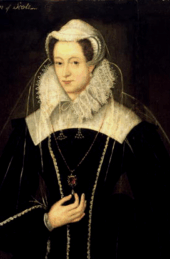Shadow of A Queen
As I am by no means the first to observe, history, like hindsight, tends to be 20/20 vision. We know how things turned out in the end and we often assume that this was the way they were meant to be – whereas of course the men and women actually living through the events we look back on had no idea what on earth was going to happen next. Nor, indeed, much of a clue about what was happening day-to-day around them – what would turn out to be important and what not. But there were those, then as now, whose job was to look for possible dangers which might be looming and work to avert them if they could – never knowing, as I say, what the outcome of their work might ultimately be.
This is clearly exemplified by the problem of Mary, Queen of Scots.
History has painted Mary Stuart as a romantic victim of the darkest Elizabethan spycraft; and yet at the time, those in power saw her as a real and present danger to their Queen and their way of life. Time after time Elizabeth escaped death at the hands of Mary’s supporters by the narrowest of margins, while the woman many saw as the legitimate queen waited, caged in a series of castles, for the chance to take the throne and return the country to ‘the Auld alliance’ with Catholic France and the Old (Roman) Religion. And their fears were by no means groundless.
Mary was the grand-daughter of Henry VIII’s elder sister Margaret, great grand-daughter in direct line from Henry VII. Henry VIII was therefore her great-uncle. True, he wrote Margaret and her Scottish successors out of the line of succession after she married James IV, but that was likely to have been because he wanted to keep the royal power in England and moreover, Scotland maintained the ‘Auld alliance’ with France while often at war with England; a war in which Mary’s grandfather James Stewart, King James IV, died (at Flodden) and her father James V died of cholera or dysentery soon after the defeat of his army at Solway Moss. Both fighting the English. Mary, however, even as Queen of France (as well as of Scots) kept the English Royal arms quartered in her own coat of arms, emphasising her closeness to the English line of succession.
Compare this with Mary’s cousin Elizabeth, who was technically (in some eyes) not even a Tudor, let alone of importance in the line of succession, in Henry’s version of which she did not, of course, feature at all. Her mother, Anne Boleyn, was stripped of her royal title before she was beheaded. Elizabeth, no longer a princess, therefore, was branded a bastard by Henry himself. And, as one of the crimes Anne was accused of was incest with her brother George, Elizabeth might even have been a mere Boleyn.
When Elizabeth did manage to succeed her elder sister Mary (a very close-run thing, by no means a certainty at all), things got worse. She declined the suit of her widowed brother-in-law King Philip of Spain, and every other suitor – Catholic or Protestant – who followed. When her decision to remain as an Anglican became clear, Pope Pius V passed the Bull Regnans in Excelsis (February 1570) excommunicating her, naming her heretic and absolving all Catholics in England of any duty towards her. Assassinating her, apparently became seen as a pathway to Heaven – a pathway lined with 25,000 Spanish crowns, indeed. This ‘fatwa’ of course may seem extreme to the modern eye, but (in the view of missionary priests like Father John Ballard, the main motor of the Babington plot) by remaining with the Protestant faith, Elizabeth was condemning almost all of her Catholic subjects – who could not hear Mass, confess their sins or receive absolution – to an eternity in Hell. England was literally Godless, defenceless against Satan and his minions, who were as keen as the Catholic Kings and Princes in Europe to invade. Ballard reportedly performed many exorcisms alongside the masses that he said in secret all over demon-haunted England. And of course, as Mephistophilis famously – if dangerously – said to Marlowe’s Faustus on the London stage day after day, ‘Why this is Hell, nor am I out of it…’
Is it any wonder that the Catholic Queen of Scots who stood so strongly in the line of succession was so tempting to so many of the disaffected at home and abroad? And, therefore, such an inevitable target for close scrutiny by the Secret Service as she remained in England, year after year? After all, it would only take one fatal bout of sickness like the smallpox that nearly killed her in 1562, a fall from a horse, a slip on the stair – without even counting the men, great and common, near and far, who were ceaselessly plotting her downfall – and, latterly her death – to bring about Queen Elizabeth’s end. But many in power simply believed Mary’s succession would inevitably lead to the ‘bonfires’ (such as those of Cranmer and Latimer) that Lord Burghley had seen in Bloody Mary’s reign, and massacres like that of Saint Bartholomew’s Eve, through which Francis Walsingham had lived as English ambassador to France.
How surprising is it, even to our more ‘modern’ way of thinking, that, after Ridolfi’s plotting, the Rising of the Northern Lords, a pot-shot taken at her barge which wounded one of her bargemen, the plotting of Sir Francis Throckmorton, John Somerville, Dr William Parry and Sir John Neville and their associates, all of whom planned her death, that those tasked with keeping Elizabeth alive and on the throne in spite of the Queen of Scots and her increasingly desperate supporters, might turn to a pre-emptive strike?
And so we come to The Babington Plot…
Peter Tonkin is an author of historical fiction. His novel, Shadow of a Queen, charting the downfall and execution of Mary Queen of Scots from the point of view of English intelligence agent Robert Poley, was published in October 2025 by Sharpe Books.







